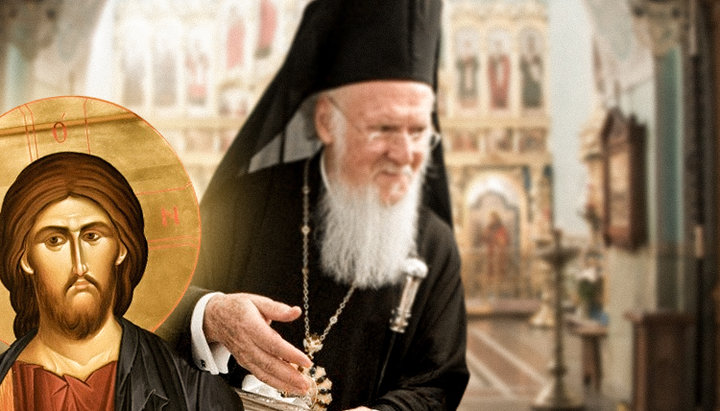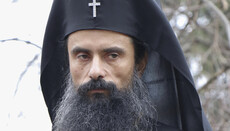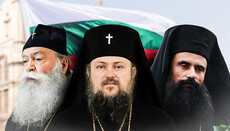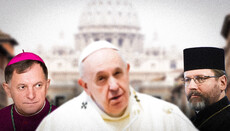What does Patriarch have that Christ lacks? What Phanar and ROC disagree on

A look at the Church from Constantinople and from Moscow in the language of documents.
The confrontation between the Patriarchates of Constantinople and Moscow after the creation of the Orthodox Church of Ukraine is the practical implementation of two different ecclesiological concepts formulated in the documents of these Churches several years before the current events. An analysis of these documents will help to understand the essence of this confrontation and realize what is at stake.
Ravenna conflict
On October 13, 2007, the 10th plenary session of the Joint International Commission for the Theological Dialogue between the Roman Catholic Church and the Orthodox Church, which discussed a range of issues, was held in Ravenna as part of the Orthodox-Catholic dialogue. The main one was the question of primacy in the Church. The result of the work was the signed document "Ecclesiological and Canonical Consequences of the Sacramental Nature of the Church. Ecclesial Communion, Conciliarity and Authority".
We will not analyze the document itself, but for those wishing to do this we advise the following publications:
- Archimandrite Georgios (Kapsanis), abbot of the Gregoriou Monastery of Mount Athos, “The Ravenna Document and Papal Primacy”;
- Ioannis Kornarakis, Emeritus Professor of Pastoral Psychology and Confession, University of Athens, “The Ravenna Document - the Guise of the Theological Dialogue”;
- СFr. Miladin Mitrovic “The Ravenna Document in the Light of the Vatican's Policy”.
The main provision of the Ravenna Document, which caused controversy between the Patriarchate of Constantinople and Moscow, is the question of primacy in the Church, or rather, a statement that in the I millennium AD (before 1054) the Eastern Local Churches recognized the Bishop of Rome as “protos of the bishops of primatial sees" in the church.
Yes, the Orthodox subscribed to this wording and, in principle, had grounds, since Canon 3 of the Second Ecumenical Council (381) reads: “The Bishop of Constantinople, however, shall have the prerogative of honour after the Bishop of Rome, because Constantinople is New Rome.” And Canon 36 of the VI Ecumenical Council (680-681) says: "We decree that the see of Constantinople shall have equal privileges with the see of Old Rome, and shall be highly regarded in ecclesiastical matters as that is, and shall be second after it."
Thus, the canons of the Ecumenical Councils really put the see of Rome first among the Local Churches. And the fact that the Eastern Churches recognized this situation in the I millennium AD is also beyond doubt. But the Orthodox, consciously or not, let themselves be deceived. Latins would not have been Latins if they had not once again demonstrated their Jesuit cunning.
The fact is that the Latin term “protos”, which the Ravenna Document assigned to the Roman pontiff, admits its understanding as the first among equals, which really corresponds to the Orthodox view of the Roman popes in the I millennium AD and its understanding as the supreme, highest, most important. In Catholicism, this is traditionally filled with the meaning that the popes have exclusive authority over all bishops. And this is a completely different matter. And therefore, the signature of the Orthodox to the Ravenna Document is a very big step towards the recognition of popes as dominant in the Christian world.
This is precisely how the representative of the Vatican, the head of the Pontifical Council for Promoting Christian Unity, Cardinal Walter Kasper, understood everything that happened in Ravenna. After the session, he stated that the Ravenna Document “paves the way for the Orthodox Churches to recognize the primacy of the Bishop of Rome”. He clarified that this path would be very long: "This document is only the first small step, and as such it gives reason for hope, but we should not exaggerate its significance."
The signature of the Orthodox to the Ravenna Document is a very big step towards the recognition of popes as dominant in the Christian world.
But Kasper rightly stated that the Orthodox took this path, and as you know, the biggest path begins with one small step. And this step has been taken. The Cardinal said: “An important achievement (of the Ravenna Document – Ed.) is that for the first time the Orthodox Churches said ‘yes’ to the very fact of the existence of this ecumenical level of the Church, and also to the fact that conciliarity, synodality and power are present at this level. This means that there is also primacy, and according to the practice of the ancient Church, the first bishop is the bishop of Rome.”
That is today the Orthodox recognized that the Pope was the protos in the I millennium AD. Tomorrow at the next session of some commission on the Orthodox-Catholic dialogue, the Latins will push through their Catholic understanding of this protos. Then there will be a talk about the status of the Pope in the II millennium AD, etc. Cardinal Kasper outlined the theme of future meetings, saying that they will "return to the role of the Bishop of Rome in the Ecumenical Church during the I millennium".
The question of the primacy in the Church is raised within the framework of the Orthodox-Catholic dialogue. The ultimate goal of such discussions is the possibility to reunite the Western Roman and Eastern Churches that existed until 1054, having come to a consensus on the primacy, and, as a consequence, on the role of the Pope.
It is clear why today the Patriarchate of Constantinople is so eager to assert its primacy among the Local Orthodox Churches. Firstly, it gives it the opportunity to take further steps towards rapprochement with the Vatican on behalf of the entire Orthodox world. Secondly, if such a rapprochement is crowned with a certain unity, the Patriarch of Constantinople will sit, as they say, at the right hand of the Pope.
Aspiration to primacy
The signing of the Declaration highlighted the internal tensions between the Patriarch of Constantinople and the Moscow Patriarchate. The Russian Orthodox Church, the only one of all the Local Orthodox Churches, did not sign the Ravenna Document.
At the very first session of the Commission in Ravenna, it was discovered that representatives of the so-called “Estonian Apostolic Orthodox Church”, which the Phanar created in 1996 as unlawfully as the OCU in 2018, were participating in it. Protesting against the participation of Estonians, the delegation of the ROC led by the current head of the Department for External Church Relations of the Moscow Patriarchate, Metropolitan Hilarion (Alfeyev), walked out of the talks and never returned.
And a few days later, Metropolitan Hilarion stated his fundamental disagreement with the provisions of the Ravenna Document and gave a very accurate forecast on which path the Orthodox-Catholic dialogue would take:
“What is the specific role of the bishop of the 'first throne' in the ecclesiology of communion? This question should serve as the starting point of the next stage of the dialogue when the question of primacy in the Ecumenical Church will be put on the agenda. And here, apparently, we will find ourselves in a trap. Namely: Catholics will try to formulate an ecclesiological model of the Ecumenical Church so that the role of the 'first bishop' is described as close as possible to that played by the Pope in the current Catholic Church. In turn, the Patriarchate of Constantinople will search for the 'primus' to have those rights that the Patriarch of Constantinople today does not have in the Orthodox Church but obviously would like to have."
These words were said in 2007. They turned out to be prophetic, at least with regard to the Patriarchate of Constantinople.
Disagreeing with the Ravenna document, the Holy Synod of the Russian Orthodox Church instructed the Synodal Theological Commission to study the issue and prepare the official position of the Moscow Patriarchate. The Commission studied the issue for six years, and in time for the Catholic (including the Patriarchate of Constantinople) Christmas of 2013. The Holy Synod adopted the official document “Position of the Moscow Patriarchate on the problem of primacy in the Universal Church”.
The Phanariots studied this document much more quickly than the Russians – the Declaration of Ravenna, and two weeks later, at Orthodox Christmas 2014, the official website of the Patriarchate of Constantinople published the answer: “First without equals: A response to the text on primacy of the Moscow Patriarchate."
What is the fundamental difference in views on the Church formulated by the Moscow and Constantinople Patriarchates?
To concessions to the Latins or to isolation
To begin with, let's compare the very first words of the “Position of the Moscow Patriarchate ...” and the response to it, coming immediately after the opening phrase.
The "Position" of the ROC begins with the assertion of the primacy of Christ in the Church: "The Holy Church of Christ, primacy belongs to her Head – our Lord and Saviour Jesus Christ, the Son of God and the Son of Man. According to St. Paul, the Lord Jesus Christ is the head of the body, the church: who is the beginning, the firstborn from the dead; that in all things he might have the pre-eminence (Col. 1:18).”
The Phanar's “Response” begins with a rebuke to the ROC: “In a recent synodal decision, the Church of Russia seems once again to choose its isolation from both the theological dialogue with the Roman Catholic Church and the communion of the Orthodox Churches.”
Given that this “theological dialogue with the Roman Catholic Church” has a clear direction of gradual concessions to the Latins by the Orthodox, self-isolation from such a dialogue is probably the only way to remain Orthodox.
As for reproaching the Russian Orthodox Church in regard to "the communion of the Orthodox Churches", the words of the Monk Maximus the Confessor (7th century) come to mind. When asked what he would do if all the bishops accepted Monothelitism and communed with Patriarch Sergius of Constantinople, who fell into this heresy, the monk answered: “If the whole universe begins to take communion with the patriarch, I will not take communion with him. The Holy Spirit anathematized through the apostle even angels introducing something new and alien to the sermon.”
Does the Ecumenical Church have a power vertical?
The modern structure of the visible Church is such that She, being one in the sacred dimension, administratively consists of independent (autocephalous) Churches, which in turn consist of dioceses. And the Holy Synod of the ROC in its “Position”, professing the single and unlimited primacy of Christ in the Church, both on earth and in heaven, further discusses primacy at:
- the local level – diocese (eparchy);
- the regional level – autocephalous Church;
- the global level – the Universal Church (not to be confused with the Patriarchate of Constantinople).
The ROC claims that the primacy at each of these levels has different sources of its existence, different nature and different content.
At the local level, the primacy belongs to the bishop and has a sacred nature: "The source of the bishop’s primacy in his diocese is the apostolic succession handed down through episcopal consecration." In accordance with this nature, "in his church domain, the bishop has full power, sacramental, administrative and magisterial".
The primacy at the regional level is fundamentally different from the primacy in the diocese. In the autocephalous Church, primacy belongs to the bishop elected as Primate of the Local Church by a Council of her bishops: “The source of primacy on the level of the autocephalous Church is the election of the pre-eminent bishop by a Council (or a Synod) that enjoys the fullness of ecclesiastical power.”
Thus, the Primate in the Local Church does not receive this primacy as a special grace but as some special powers combined with a special responsibility. The Primate of the Church is subordinate to the Council, which may remove him from this primacy or annul (not approve) his decision: "The power of the Primate in an autocephalous Local Church is different from that of a bishop in his church domain: it is the power of the first among equal bishops."
The primus cannot manage the Local Church alone as a bishop in his diocese, but he does this only with the help of other bishops (the Council or the Synod). The Council may, at its discretion, narrow or expand the specific managerial powers of the Primate, as reflected in the statute of a particular Local Church.
As for the universal level, the “Position” draws attention to the following points:
- the Orthodox Church at the universal level knows exclusively the primacy of honour;
- the holy canons say nothing about the meaningful content of this concept "primacy of honour";
- the holy canons do not vest the primus at the universal level with any powers on the church-wide scale.
The source of this church-wide primacy of honour is the decisions of the Ecumenical Councils, which establish the order of primacy among the most ancient Local Churches as the following: Roman, Constantinople, Alexandria, Antioch and Jerusalem. All other Local Churches were added to the Diptych after the era of Ecumenical Councils. After the Eucharistic community between Rome and Constantinople was broken in 1054, primacy in the Orthodox Church went to the next see in the diptych order, namely, to that of Constantinople. Since that time up to the present, the primacy of honour in the Orthodox Church at the universal level has belonged to the Patriarch of Constantinople as the first among equal Primates of Local Orthodox Churches.
The Holy Synod of the ROC agrees that today the Patriarchate of Constantinople can carry out certain general church functions (although nothing is said about it in the canons of the Church), but only if the other Local Churches authorize it: “In exercising his primacy in this way, the Primate of the Church of Constantinople can offer initiatives of general Christian scale and address the external world on behalf of the Orthodox plenitude provided he has been empowered to do so by all the Local Orthodox Churches.”
The ROC also says that due to the different nature, different sources and different content of the concept of primacy at the local, regional and universal levels it cannot be considered identical or even similar: “Due to the fact that the nature of primacy, which exists at various levels of church order (diocesan, local and universal) vary, the functions of the primus on various levels are not identical and cannot be transferred from one level to another." In other words, these three levels of primacy cannot be regarded as a kind of a power vertical.
The source of primacy for oneself
What did the Patriarchate of Constantinople respond to this? His “Response” does not have the force of an official document adopted by the Synod or Council. This response was written by Metropolitan Elpidophoros (Lambriniadis), the then Metropolitan of Bursa, and now the head of the American Archdiocese of the Patriarchate of Constantinople. However, despite the informality, the “Response” has acquired a mandatory status due to the reception – it is the concept (first without equal) set forth in it that the Patriarch Bartholomew and the hierarchs of the Patriarchate of Constantinople are guided by in their practical activities.
Metropolitan Elpidophoros, starting with reproaches to the ROC, also speaks of primacy at the local, regional and universal levels. But he does not agree with the statement of the “Position” that the primacy of our Lord Jesus Christ in the Church is primary, and the primacy of bishops is secondary: “Thus, the text of the Moscow Patriarchate is forced to adopt the unprecedented distinction between, on the one hand, the 'primary' primacy of the Lord and, on the other hand, the 'secondary' primacies of bishops (‘various forms of primacy <…> are secondary’).”
So, Metropolitan Elpidophoros claims that the primacy of the bishop is the same as the primacy of Jesus Christ, it is not secondary. And from the further text of his “Response”, it becomes clear why he gives such an absurd (if not blasphemous) statement. He says that the primacy of not just a bishop but of the Patriarch of Constantinople is essentially the same as the primacy of Christ.
Metropolitan Elpidophoros gives the relationship of the Persons of the Holy Trinity as an example of primacy and, having absolutely no theological justification for that, projects them onto the concept of primacy in the Church and, according to his “Response”, to the relationship of the Patriarch of Constantinople with the primates of other Local Churches: “In order to understand this innovations more clearly, let us look for a moment at what all this would mean if we related and applied them to the life of the Holy Trinity, the true source of all primacy. <...> The Church has always and consistently understood the person of the Father as the first in the communion of persons of the Holy Trinity ("the monarchy of the Father"). If we were to follow the logic of the text of the Synod of Russia, we would also have to claim that God the Father is not Himself the anarchic cause of the divinity and fatherhood, <...> but becomes a recipient of his own ‘primacy’.”
"The Patriarchate of Constantinople will search for the "primus" to have those rights that the Patriarch of Constantinople today does not have in the Orthodox Church but obviously would like to have."
Metropolitan Hilarion (Alfeyev), Head of the Department for External Church Relations of the Moscow Patriarchate, 2007.
In addition to the completely far-fetched and arbitrary transfer of the “life of the Holy Trinity” to the relationship between the autocephalous Churches, Metropolitan Elpidophoros throughout the text of the “Response” is engaged in verbal equilibristics and juggling philosophical terms and concepts in the best traditions of medieval Latin scholasticism.
Have a closer look, for example, at the following phrase: “… the position of the Moscow Patriarchate insists so greatly on determining the sources of primacy, which always differ from the person of the primus, in such a way that the primate becomes the recipient, rather than the source of his primacy. Does perhaps this dependence also imply the autonomy of primacy? For the Church, an institution is always hypostasized in a person. We can never encounter an impersonal institution, as it would be if primacy were to be conceived independently of a primate. It should be clarified here that the primacy of the primus is also hypostasized by the specific place, the local Church, the geographical region over which the primate presides.”
Having said that the primacy of God the Father among the Persons of the Holy Trinity does not have a source of God the Son and God the Holy Spirit, Metropolitan Elpidophoros ends the “Response” by stating the same thing with respect to the Patriarch of Constantinople: “If we are going to talk about the source of a primacy, then the source of such primacy is the very person of the Archbishop of Constantinople, who precisely as bishop is one ‘among equals’ but as Archbishop of Constantinople, and thus as Ecumenical Patriarch is the first without equals (primus sine paribus).”
Now think about what this statement means: the source of primacy in the Church is the very personality of the Archbishop of Constantinople! Metropolitan Elpidophoros claims that the Patriarch of Constantinople himself is the source of his primacy in the Church!
But the Apostle Paul, speaking of the primacy of the Lord Jesus Christ in the Church, claimed that He has as the source of this primacy not Himself but God the Father: “The God of our Lord Jesus Christ, the glorious Father, may give you the Spirit of wisdom and revelation, so that you may know Him better. I pray that the eyes of your heart may be enlightened in order that you may know the hope to which He has called you, the riches of His glorious inheritance in His holy people, and His incomparably great power for us who believe. That power is the same as the mighty strength He exerted when He raised Christ from the dead and seated Him at his right hand in the heavenly realms, far above all rule and authority, power and dominion, and every name that is invoked, not only in the present age but also in the one to come. And God placed all things under His feet and appointed Him to be head over everything for the Church, which is His body, the fullness of Him who fills everything in every way.” (Eph. 1, 17-23)
* * *
Reading the “Response” of Metropolitan Elpidophoros and his statement that the Patriarch of Constantinople has what even our Lord Jesus Christ lacks, namely, his own and not received primacy from others, we involuntarily recall other words of the Holy Scripture: “How you have fallen from heaven, morning star, son of the dawn! You have been cast down to the earth, you who once laid low the nations! You said in your heart, ‘I will ascend to the heavens; I will raise my throne above the stars of God; I will sit enthroned on the mount of assembly, on the utmost heights of Mount Zaphon. I will ascend above the tops of the clouds; I will make myself like the Most High.’ But you are brought down to the realm of the dead, to the depths of the pit.” (Isa. 14, 12-15)
Now the scale and depth of the struggle we see today become clearer. This is not just a struggle for who should decide on the "Ukrainian question" – the Patriarch of Constantinople or the Pan-Orthodox Council. And not even for whether or not the Patriarch of Constantinople will succeed in bringing obedient Local Churches to a union with Rome.
This is a struggle for whether we, on the basis of the Holy Scripture and the legacy of the Holy Fathers, will recognize the undivided primacy of Jesus Christ in the Church or the primacy of an earthly man who has the source of his primacy in his own personality.





